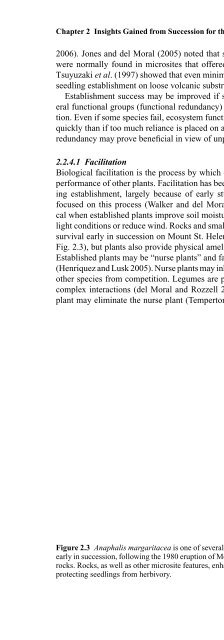Linking Restoration and Ecological Succession (Springer ... - Inecol
Linking Restoration and Ecological Succession (Springer ... - Inecol
Linking Restoration and Ecological Succession (Springer ... - Inecol
You also want an ePaper? Increase the reach of your titles
YUMPU automatically turns print PDFs into web optimized ePapers that Google loves.
Chapter 2 Insights Gained from <strong>Succession</strong> for the <strong>Restoration</strong> of L<strong>and</strong>scape Structure <strong>and</strong> Function 27<br />
2006). Jones <strong>and</strong> del Moral (2005) noted that seedlings on a glacial forel<strong>and</strong><br />
were normally found in microsites that offered substantial protection, while<br />
Tsuyuzaki et al. (1997) showed that even minimal surface instability restricted<br />
seedling establishment on loose volcanic substrates.<br />
Establishment success may be improved if several species in each of several<br />
functional groups (functional redundancy) are employed early in restoration.<br />
Even if some species fail, ecosystem functions are likely to develop more<br />
quickly than if too much reliance is placed on a few species. Using functional<br />
redundancy may prove beneficial in view of unpredictable global change.<br />
2.2.4.1 Facilitation<br />
Biological facilitation is the process by which established plants improve the<br />
performance of other plants. Facilitation has been the process emphasized during<br />
establishment, largely because of early studies of succession that were<br />
focused on this process (Walker <strong>and</strong> del Moral 2003). Facilitation is physical<br />
when established plants improve soil moisture availability, temperature, or<br />
light conditions or reduce wind. Rocks <strong>and</strong> small channels augmented seedling<br />
survival early in succession on Mount St. Helens (del Moral <strong>and</strong> Wood 1993;<br />
Fig. 2.3), but plants also provide physical amelioration (Barchuk et al. 2005).<br />
Established plants may be “nurse plants” <strong>and</strong> facilitate seedling establishment<br />
(Henríquez <strong>and</strong> Lusk 2005). Nurse plants may inhibit one species, thus releasing<br />
other species from competition. Legumes are particularly likely to have such<br />
complex interactions (del Moral <strong>and</strong> Rozzell 2005). Eventually, the fostered<br />
plant may eliminate the nurse plant (Temperton <strong>and</strong> Zirr 2004). Shrubs often<br />
Figure 2.3 Anaphalis margaritacea is one of several species that were able to establish<br />
early in succession, following the 1980 eruption of Mount St. Helens, by lodging among<br />
rocks. Rocks, as well as other microsite features, enhance moisture <strong>and</strong> nutrients, while<br />
protecting seedlings from herbivory.

















